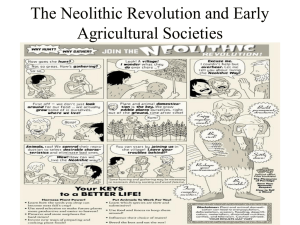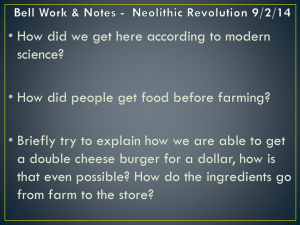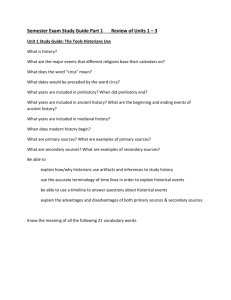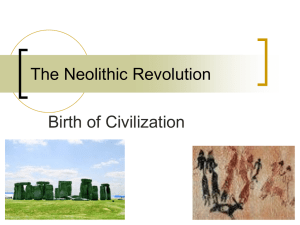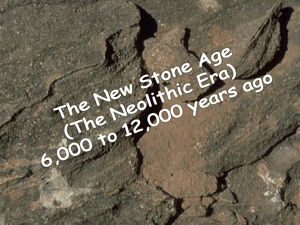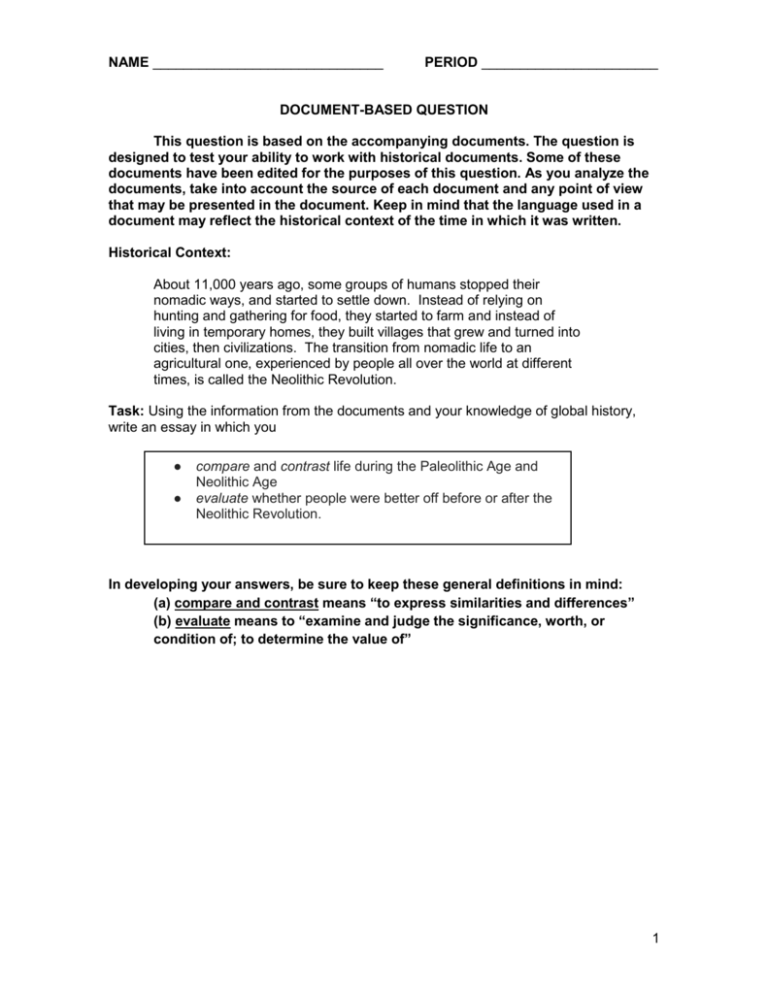
NAME ______________________________
PERIOD _______________________
DOCUMENT-BASED QUESTION
This question is based on the accompanying documents. The question is
designed to test your ability to work with historical documents. Some of these
documents have been edited for the purposes of this question. As you analyze the
documents, take into account the source of each document and any point of view
that may be presented in the document. Keep in mind that the language used in a
document may reflect the historical context of the time in which it was written.
Historical Context:
About 11,000 years ago, some groups of humans stopped their
nomadic ways, and started to settle down. Instead of relying on
hunting and gathering for food, they started to farm and instead of
living in temporary homes, they built villages that grew and turned into
cities, then civilizations. The transition from nomadic life to an
agricultural one, experienced by people all over the world at different
times, is called the Neolithic Revolution.
Task: Using the information from the documents and your knowledge of global history,
write an essay in which you
●
●
compare and contrast life during the Paleolithic Age and
Neolithic Age
evaluate whether people were better off before or after the
Neolithic Revolution.
In developing your answers, be sure to keep these general definitions in mind:
(a) compare and contrast means “to express similarities and differences”
(b) evaluate means to “examine and judge the significance, worth, or
condition of; to determine the value of”
1
Part A
Short-Answer Questions
Directions: Analyze the documents and answer the short-answer questions that follow
each document in the space provided.
Document 1
1
Environmental changes brought new climate patterns that contributed to the end of
2
the Old Stone Age [Paleolithic Era]. Warmer weather allowed plants to grow
3
where, previously, sheets of ice had dominated the landscape.
4
5
Around 10,000 B.C., people made two important discoveries. They learned to
6
plant seeds to grow food, and they learned to domesticate animals. These
7
discoveries meant that people no longer had to wander in search of food. They
8
could live in permanent settlements. This change marked the beginning of the
9
New Stone Age, or Neolithic period. Historians call these discoveries the Neolithic
10
Revolution, or the Agricultural Revolution, because farming and domestic animals
11
changed the way people lived.
Source: Steven Goldberg and Judith Clark Dupre. Prentice Hall Brief Review: Global History and Geography. New York: Pearson
Prentice Hall, 2012. Page 3.
1a. What does the author mean by “permanent settlements” in lines 7-8?
____________________________________
__________________________________
1b. What does it mean to “domesticate animals” as it is used in line 6?
____________________________________
__________________________________
1c. According to Document 1, what were the “environmental changes” that led to the end
of the Paleolithic Era?
____________________________________
__________________________________
1d. According to Steven Goldberg and Judith Clark Dupre, what “two important
discoveries” did people make around 10,000 BC?
____________________________________
____________________________________
2
1e. Define the term Neolithic Revolution.
____________________________________
____________________________________
_________________________________
1f. Based on Document 1, explain how the Neolithic Revolution changed the lives of those
who experienced it.
____________________________________
____________________________________
_________________________________
____________________________________
__________________________________
Document 2
Paleolithic Era
(Old Stone Age)
2,000,000 B.C.E. - 8,000 B.C.E.
Neolithic Era
(New Stone Age)
8,000 B.C.E.- 2,000 B.C.E.
Lifestyle
Nomadic; in groups of up to 50;
tribal society; hunters and
gatherers
Sedentary....They farmed in
permanent settlements and
raised/herded animals; agriculture
was discovered and became a major
source of food; families evolved.
Economy
There was no concept of private
property
The concept of private property and
ownership emerged for things such
as land, livestock and tools.
Art
Cave paintings
Wall paintings
Technology
Fire; Rough stone tools
Agriculture and tools with polished
stones
Food
Hunted and gathered for their
food supply.
They grew crops such as corn,
wheat, beans, etc. Raised/herded
animals for milk and meat.
Source: Dates from Bulliet, Crossley, Headrick, Hirsch, and Johnson. The Earth and Its Peoples, Cengage Learning, p. 20. Table
adapted from http://www.diffen.com/difference/Neolithic_vs_Paleolithic
3
2a. What does the author mean by “nomadic” in the second row of the table?
____________________________________
__________________________________
2b. Based on the table above, explain the difference between a “nomadic” and
“sedentary” lifestyle.
____________________________________
__________________________________
2c. How did Paleolithic people’s lifestyle differ from Neolithic people’s lifestyle?
____________________________________
____________________________________
_________________________________
2d. How did the methods for acquiring food differ between the Paleolithic and Neolithic
Eras?
____________________________________
____________________________________
_________________________________
4
Document 3
Image A
Image B
Image C
Image D
------------------------------------------------------------------------------------------1
Throughout history, and even today, there have been some groups of people in the world
2
that live nomadic lifestyles. The images above show a nomadic tribe of Bedouins who
3
lived in the Moab Desert in the late 1800s. The pictures were taken by an American named
4
Archibald Forder who lived in the Middle East with the tribe for thirteen years. Though
5
these images were not taken during the Paleolithic Era, they depict how some people may
6
have lived at that time.
Source: Photographs by Archibald Forder, from “Ventures among the Arabs in Desert, Tent, and Town: Thirteen Years of Pioneer
Missionary Life with the Ishmaelites of Moab, Edom, and Arabia.” W.N. Hartshorn, Boston. 1905. Found on the World Digital Library:
http://www.wdl.org/en/item/11763/#q=nomadic
3a. When, where, and by whom were these photographs taken?
____________________________________
__________________________________
5
3b. Describe the lifestyles of the Bedouins depicted in the Document 3 images.
____________________________________
____________________________________
_________________________________
3c. The text accompanying this document describes the people pictured as “nomadic,”
what does that mean?
____________________________________
____________________________________
_________________________________
3d. How did the Bedouin way of life, depicted in these images, make it easier for them to
be nomadic?
____________________________________
____________________________________
_________________________________
6
Document 4
Tools from Hunter-Gatherer Societies
1
Hunter-gathering societies have used various types of stones, as well as bone and
2
antler, to make a variety of tools such scrapers, blades, arrows, spearheads,
3
needles, awls, fishhooks, and harpoons. The 6.5- to 6.7-cm (2.5- to 2.6-inch) flint
4
blades on the left are from North Africa, dating from 5000–4500 BCE. The 5.7- x
5
4.6-cm (2.2- x 1.8-inch) scraper on the right is made of green jasper, dates from
6
5200 to 2500 BCE, and was found in the south-central Sahara Desert.
Source: http://www.worldmuseumofman.org/display.php?item=1167;
http://www.worldmuseumofman.org/display.php?item=434 adapted from The Big History Project.
4a. How big were the tools used by hunter-gatherers depicted in Document 4?
____________________________________
__________________________________
4b. According to Document 4, what materials did hunter-gatherers use to make their
tools?
____________________________________
____________________________________
_________________________________
7
Document 5
Richard Lee is a Canadian anthropologist who has written a number of books and articles
on hunter-gatherer societies in southern Africa. This excerpt describes the lifestyle of a
Bushmen tribe.
“What Hunters Do for a Living”
1
A woman gathers on one day enough food to feed her family for three days, and
2
spends the rest of her time resting in camp, doing embroidery, visiting other
3
camps, or entertaining visitors from other camps. For each day at home, kitchen
4
routines, such as cooking, nut cracking, collecting firewood, and fetching water,
5
occupy one to three hours of her time. This rhythm of steady work and steady
6
leisure is maintained throughout the year. The hunters tend to work more
7
frequently than the women, but their schedule is uneven. It is not unusual for a
8
man to hunt avidly for a week and then do no hunting at all for two or three weeks.
9
Since hunting is an unpredictable business and subject to magical control, hunters
10
sometimes experience a run of bad luck and stop hunting for a month or longer.
11
During these periods, visiting, entertaining, and especially dancing are the primary
activities of men.
Source: Richard Lee, “What Hunters Do for a Living,” in Man the Hunter, eds. R.B. Lee and I. DeVore (Chicago: Aldine, 1968)
adapted from The Big History Project.
5a. What does the word “leisure” mean in line 5?
____________________________________
____________________________________
_________________________________
5b. Identify two responsibilities that women have in the Bushmen tribe.
____________________________________
____________________________________
_________________________________
5c. Identify the responsibility that men have in the Bushmen tribe.
____________________________________
____________________________________
_________________________________
8
5d. How much leisure time did Bushmen (and women) have? How much time did they
spend working?
____________________________________
____________________________________
_________________________________
5e. What evidence from Document 5 supports the claim that people were better off before
the Neolithic Revolution?
____________________________________
____________________________________
_________________________________
____________________________________
__________________________________
5f. What evidence from this text supports the claim that people were better off after the
Neolithic Revolution?
____________________________________
____________________________________
_________________________________
____________________________________
__________________________________
9
Document 6
Should you be Eating like a Caveman?
1
…Dr. Eaton, a radiologist, and Cordain, an exercise physiologist… believe
2
evolutionary forces dictate that we will live healthiest when we consume a diet
3
similar to what early man ate 2.5 million years ago during the hunter-gatherer days
4
of the Paleolithic Era. This diet included more (low-fat) proteins and (healthy) fats
5
than most of us eat today, and fewer carbohydrates, mainly because Paleo man
6
ate no wheat, rice, or corn whatsoever. These modern grains were not "invented"
7
until 10,000 years ago. In other words, throughout 99.6 percent of our evolutionary
8
history, we ate no bread, pancakes, pasta, or chow mein. As a result, they say, we
9
aren't adapted to process them healthfully.
10
11
… Cordain first learned about Paleo nutrition in 1985 when the New England
12
Journal of Medicine published a "Special Article" by Dr. Eaton and his colleague
13
Melvin Konner. In that article, the authors concluded that the Paleo diet contained
14
vastly more vitamin C, fiber, calcium, iron, folate, and essential fatty acids than our
15
current supermarket-based fare. It also contained far less sugar, salt, and
16
saturated fats. They concluded: "The diet of our remote ancestors may be a
17
reference standard for modern human nutrition and a model for defense against
18
certain 'diseases of civilization.'"
19
20
It’s easy to make fun of the Paleo diet. Right away, everyone says, “Sure, and how
21
long did your basic caveman live?” About 20 to 25 years, it turns out. But primitive
22
hunter-gatherers didn't die from heart disease, diabetes, and high blood pressure
like we do. They died from germs, viruses, and traumas. We live longer today, in
large part, because we have sewers, inoculations, and amazing (if expensive)
health-care systems.
Source: Amby Burfoot, “Should you be Eating like a Caveman?” Runner's World (Dec2005).
6a. What does the word “consume” mean in line 2?
____________________________________
____________________________________
_________________________________
10
6b. According to the article, which foods are humans not “adapted” to “process
healthfully?” (line 8)?
____________________________________
____________________________________
6c. According to Amby Burfoot, how were the diets of Paleolithic people different than
most people’s diets today?
____________________________________
____________________________________
_________________________________
6d.What is the author’s claim? What reasons does he give to support it?
____________________________________
____________________________________
____________________________________
____________________________________
____________________________________
______________________________
6e. In the author’s argument, what is the purpose of the third paragraph?
____________________________________
____________________________________
_________________________________
11
Document 7
Source: Vivienne Hodges, New York State Global History Regents Coach, Educational Design, Inc. (adapted) found in the June 2003,
NYS Global History and Geography Regents Exam.
7a. According to the timeline in Document 7 the event “First crops grown in Middle East”
occurred around 8,000 BC. What are “crops?”
____________________________________
____________________________________
_________________________________
7b. Refer back to Document 1, what does “domestication” mean? According to the
timeline in Document 7, what was domesticated during the Neolithic Revolution?
____________________________________
____________________________________
_________________________________
7c. According to the timeline, there were settlements “at Jericho on [the] West Bank of
[the] Jordan River,” and “at Catal Huyuk in Turkey.” What does “settlement” mean in this
context?
____________________________________
____________________________________
_________________________________
12
7d. Based on the timeline in Document 7 and the descriptions of Paleolithic life from
previous documents, describe two changes that took place during the Neolithic
Revolution.
____________________________________
____________________________________
____________________________________
____________________________________
____________________________________
______________________________
13
Document 8
1
Catal Huyuk, in modern Turkey, was one of the first places in the world where
2
humans lived in dense settlements. From about 7500 to 5700 BCE, an estimated
3
average of between 5,000 and 8,000 people lived in mud-brick houses with
4
rooftops serving as streets. James Mellaart, the British archaeologist who
5
excavated Catal Huyuk in 1958, produced this drawing of the settlement’s layout.
6
Alongside is an artist’s illustration of an individual dwelling.
Source:http://makingmaps.net/2008/10/13/cartocacoethes-why-the-worlds-oldest-map-isnt-amap/;http://www.ediciona.com/portafolio/image/5/2/0/5/casa_catal_huyuk_5025.jpg adapted from The Big History Project.
8a. Based on the information in Document 8, what does the word “dense” mean in line 2?
____________________________________
__________________________________
8b. What does “excavated” mean as mentioned in line 5?
____________________________________
__________________________________
8c. Based on Document 8, what does an archaeologist do (line 4)?
____________________________________
__________________________________
14
8d. Based on the images above, describe the lifestyles of people who lived in Catal
Huyuk.
____________________________________
____________________________________
_________________________________
8e. Compare the lives of those living in Catal Huyuk from about 7500 to 5700 BCE, to the
lives of the nomads depicted in Document 3.
____________________________________
____________________________________
____________________________________
____________________________________
____________________________________
______________________________
15
Document 9
Tools from Agricultural Societies
1
These metal tools include a crescent-shape scythe used in the harvesting of grain
2
and a square-end hoe used for weeding and other farming activities. They were
3
excavated in contemporary Spain, and date from the fourth century BCE.
Source:http://intercentres.edu.gva.es/albait/ELS%20IBERS%205/lagricultura_i_els_teixits.html adapted from The Big History Project.
9a. According to Document 9, what materials did agricultural societies use to make their
tools?
____________________________________
____________________________________
_________________________________
9b. What is a “scythe,” mentioned in the first line, used for?
____________________________________
____________________________________
_________________________________
16
9c. What were the tools depicted in Document 9, used for?
____________________________________
____________________________________
_________________________________
9d. Compare the tools pictured here from agricultural societies to those depicted in
Document 4 from hunter-gatherer societies.
____________________________________
____________________________________
____________________________________
____________________________________
____________________________________
______________________________
17
Document 10
Specialization of Labor
1
Within the villages, towns and cities, it was possible for people to specialize in the
2
sort of work they could do best. Many stopped producing food at all, making
3
instead tools and other goods that farmers needed, and for which they gave them
4
food in exchange. This process of exchange led to trade and traders, and the
5
growth of trade made it possible for people to specialize even more...
Source: D.M. Knox, The Neolithic Revolution, Greenhaven Press, adapted from the January 2004, NYS Regents Exam.
10a. What does it mean to “specialize” in a “sort of work” as stated in lines 1 and 2?
____________________________________
____________________________________
_________________________________
10b. Explain the relationship between specialized labor (work) and “the growth of trade”
(line 5).
____________________________________
____________________________________
____________________________________
____________________________________
____________________________________
______________________________
18
Document 11
Kevin Reilly is a professor of humanities at Raritan Valley Community College and was
the cofounder and first president of the World History Association.
Kevin Reilly, excerpt from The West and the World: A History of Civilization
1
The most obvious achievements of the first civilizations are the monuments — the
2
pyramids, temples, palaces, statues, and treasures — that were created for the
3
new ruling class of kings, nobles, priests, and their officials. But civilized life is
4
much more than the capacity to create monuments.
5
6
Civilized life is secure life. At the most basic level this means security from the
7
sudden destruction that village communities might suffer. Civilized life gives the
8
feeling of permanence. It offers regularity, stability, order, even routine. Plans can
9
be made. Expectations can be realized. People can be expected to act
10
predictably, according to the rules.
11
12
The first cities were able to attain stability with walls that shielded the inhabitants
13
from nomads and armies, with the first codes of law that defined human
14
relationships, with police and officials that enforced the laws, and with institutions
15
that functioned beyond the lives of their particular members. City life offered
16
considerably more permanence and security than village life.
Source: Kevin Reilly, The West and the World: A History of Civilization (New York: Harper Collins, 1989) adapted from The Big
History Project.
11a. In line 6, what does Reilly mean by “secure life?”
____________________________________
____________________________________
_________________________________
11b. Describe what a “feeling of permanence” is, as mentioned in line 8 of this excerpt.
____________________________________
____________________________________
_________________________________
19
11c. According to Reilly, how did the first cities “attain stability?” (line 12)
____________________________________
____________________________________
_________________________________
11d. What is the author’s claim in Document 11? What reasons does he give to support
it?
____________________________________
____________________________________
____________________________________
____________________________________
____________________________________
______________________________
20
Part B
Essay
Directions: Write a well-organized essay that includes an introduction, several
paragraphs, and a conclusion. Use evidence from the documents in your essay. Support
your response with relevant facts, examples, and details. Include additional outside
information.
Historical Context:
About 11,000 years ago, some groups of humans stopped their nomadic
ways, and started to settle down. Instead of relying on hunting and
gathering for food, they started to farm and instead of living in temporary
homes, they built villages that grew and turned into cities, then civilizations.
The transition from nomadic life to an agricultural one, experienced by
people all over the world at different times, is called the Neolithic
Revolution.
Task: Using the information from the documents and your knowledge of global
history, write an essay in which you
●
●
compare and contrast life during the Paleolithic Age and Neolithic
Age
evaluate whether people were better off before or after the
Neolithic Revolution.
Guidelines:
In your essay, be sure to
● Introduce your topic, creating an argument in response to the task
● Develop your argument with textual evidence while attending to the
strengths and limitations of that evidence:
○ Accurately identify all primary and secondary sources using
evidence, including the date and source of the information.
○ Make connections between the documents by comparing
information and noting discrepancies in the documents.
○ Use evidence from all of the documents to support both claim(s)
and counterclaim(s).
● Provide an accurate summary of relevant historical information, including
outside information on the topic not found in the documents when possible
● Provide a concluding statement supporting your argument.
● Maintain a formal style and objective tone in your writing.
Task
Document #
Life during the Paleolithic Age
Life during the Neolithic Age
21




